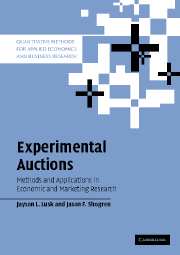Book contents
- Frontmatter
- Contents
- List of figures
- List of tables
- 1 Introduction
- 2 Incentive compatible auctions: theory and evidence
- 3 Value theory
- 4 Conducting experimental auctions: some preliminaries
- 5 Conducting experimental auctions
- 6 Data analysis
- 7 Valuation case studies
- 8 Auction design: case studies
- 9 Validity of experimental auctions
- 10 The future of experimental auctions
- References
- Index
10 - The future of experimental auctions
Published online by Cambridge University Press: 27 October 2009
- Frontmatter
- Contents
- List of figures
- List of tables
- 1 Introduction
- 2 Incentive compatible auctions: theory and evidence
- 3 Value theory
- 4 Conducting experimental auctions: some preliminaries
- 5 Conducting experimental auctions
- 6 Data analysis
- 7 Valuation case studies
- 8 Auction design: case studies
- 9 Validity of experimental auctions
- 10 The future of experimental auctions
- References
- Index
Summary
Introduction
Today researchers use experimental auctions to examine incentive and contextual questions that arise in eliciting values through stated preferences methods. The initial work developing the experimental valuation method was pioneered decades ago by researchers interested in estimating the demand for public goods, e.g., Bohm (1972), Bennett (1983), Knetsch and Sinden (1984), and Cummings et al. (1986). Most experimental auctions follow a process similar to that described by physicist James Conant (1951; p. 56): “[a]bout three centuries ago the trial-and-error experimentation of the artisan was wedded to the deductive method of reasoning of the mathematician; the progeny of this union have returned after many generations to assist the ‘sooty empiric’ in his labors.” By combining pattern recognition with theoretical insight, the “sooty empiric” uses experimental auctions to help clarify how incentives and context affect how people state their preferences for real and hypothetical goods and services.
This book has assimilated the current state of knowledge on the use of experimental auctions to elicit values for goods. Our goal is to provide a resource to practitioners interesting in designing and using experimental auctions in applied economic, psychology, and marketing research. We have covered the basics on value and auction theory to provide the analytical background for the experiments. We then addressed specific issues related to design and implementation of experimental auctions. In many cases, we offered specific advice.
- Type
- Chapter
- Information
- Experimental AuctionsMethods and Applications in Economic and Marketing Research, pp. 269 - 278Publisher: Cambridge University PressPrint publication year: 2007



